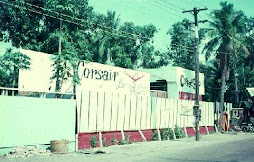2010/04/04
Bombs Away!
Texas Instruments Paveway I
I and my partner were sent out to an F4 with this laser designator system attached to the cockpit sill and the GBU slung underneath on the centerline bomb rack. Though I've forgotten the details we were to do some system integration with our radar and bombing computer system it seems. It was one of those non-existent things that didn't really exist no matter how real they appeared to the untrained eye. After the short briefing we received at the aircraft before we started we were as able to not see it as any one else.
The following text is from the above site page Re: the GBU-11/B laser guided bomb deployed to Ubon.
" The big advantage of the Paveway concept is that virtually no modifications on the delivery aircraft are necessary. The laser designators, e.g. the early AN/AVQ-10 PAVE KNIFE, or the later AN/AVQ-23 PAVE SPIKE and AN/AVQ-26 PAVE TACK, can be carried either by the delivery aircraft itself or by other aircraft in the strike group. There are also portable laser designators for ground troops. More than ten thousand Paveway I LGBs were used with great success by the U.S. Air Force over South East Asia."
It was awesome to be working on this stuff ! I was Nineteen yrs old and working on this almost experimental bombing system. Now we see it on the nightly news!
With these we were able to precision bomb the most difficult targets that were nearly immune to our bombing due to the thrown rock nature of dropping bombs at the time. We could get close, very close before Paveway. But this baby could go right down your underwear! As you see today, it is fantastic!!
As Seen On TV Guided Bomb
This innovation of bombing technology was integrated through our radar scope and as such we were the dudes responsible for setting it up to work properly. It operated on the high contrast point on the target selected by locating it in the box crosshairs that appeared on our radar screen superimposed over the video image coming from the camera attached to the nose of the bomb (Big bomb, Very big bomb). Our radar antenna joy stick moved the box on the screen image and the go button locked the system in the nosecone on to the high contrast point of the target. The bomb was released and the plane broke-off the bomb run. Hearing those pilots tell of watching those bombs glide into cave mouths and detonating inside a hill was really made us feel we were doing something important. We all were.
I and my partner were sent out to an F4 with this laser designator system attached to the cockpit sill and the GBU slung underneath on the centerline bomb rack. Though I've forgotten the details we were to do some system integration with our radar and bombing computer system it seems. It was one of those non-existent things that didn't really exist no matter how real they appeared to the untrained eye. After the short briefing we received at the aircraft before we started we were as able to not see it as any one else.
The following text is from the above site page Re: the GBU-11/B laser guided bomb deployed to Ubon.
" The big advantage of the Paveway concept is that virtually no modifications on the delivery aircraft are necessary. The laser designators, e.g. the early AN/AVQ-10 PAVE KNIFE, or the later AN/AVQ-23 PAVE SPIKE and AN/AVQ-26 PAVE TACK, can be carried either by the delivery aircraft itself or by other aircraft in the strike group. There are also portable laser designators for ground troops. More than ten thousand Paveway I LGBs were used with great success by the U.S. Air Force over South East Asia."
It was awesome to be working on this stuff ! I was Nineteen yrs old and working on this almost experimental bombing system. Now we see it on the nightly news!
With these we were able to precision bomb the most difficult targets that were nearly immune to our bombing due to the thrown rock nature of dropping bombs at the time. We could get close, very close before Paveway. But this baby could go right down your underwear! As you see today, it is fantastic!!
As Seen On TV Guided Bomb
This innovation of bombing technology was integrated through our radar scope and as such we were the dudes responsible for setting it up to work properly. It operated on the high contrast point on the target selected by locating it in the box crosshairs that appeared on our radar screen superimposed over the video image coming from the camera attached to the nose of the bomb (Big bomb, Very big bomb). Our radar antenna joy stick moved the box on the screen image and the go button locked the system in the nosecone on to the high contrast point of the target. The bomb was released and the plane broke-off the bomb run. Hearing those pilots tell of watching those bombs glide into cave mouths and detonating inside a hill was really made us feel we were doing something important. We all were.
Subscribe to:
Post Comments (Atom)


No comments:
Post a Comment